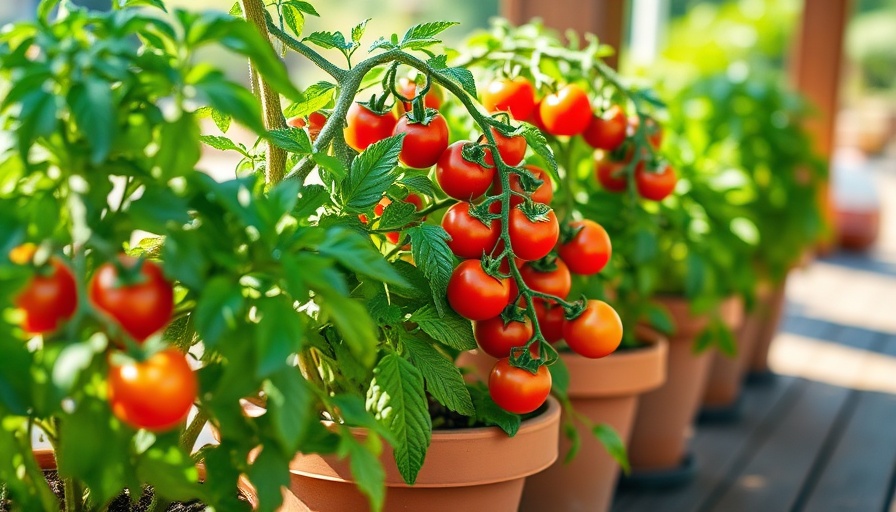
Unlocking the Secret to Thriving Potted Tomato Plants
If your garden is brimming with plants, don’t fret! Using containers to cultivate potted tomato plants is a practical solution, enabling you to maximize every inch of your space. From patios to balconies, these versatile plants adapt well anywhere. Here are seven essential tricks to ensure that your potted tomatoes not only survive but flourish, providing you with a bountiful harvest.
The Importance of Consistent Watering
First and foremost, let’s discuss water—an essential ingredient for healthy potted tomato plants. Unlike their in-ground counterparts, potted tomatoes are prone to drying out more quickly due to higher exposure to air and the absence of earth’s moisture retention. To combat this, ensure that you provide adequate watering, especially during hot summer days when they can lose moisture rapidly.
Employing methods such as drip irrigation or using a watering can allows for efficient watering. During peak summer heat, you may need to check the moisture levels daily. Opt for the finger test: if dirt clings to your fingers, watering isn’t needed; if it crumbles away, it’s time to help your tomatoes hydrate.
Choosing the Right Container Size
When deciding on the type of pots to use, size matters! Larger containers will retain moisture longer, reducing the frequency of watering needed. A general rule of thumb is to opt for containers that hold at least a few gallons of soil, providing the roots ample space to grow and find moisture. Additionally, ensuring proper drainage holes at the bottom of your containers will prevent root rot by allowing excess water to escape.
Proper Nutrition for Potted Tomatoes
Another crucial element is nutrition. Tomato plants are heavy feeders, requiring nutrients to thrive. Utilize a balanced slow-release fertilizer, mixing it into the potting soil before planting. Regular fertilizing every four to six weeks supports ongoing growth, ensuring your plants receive the necessary nutrients throughout their life cycle. This practice can lead to larger fruit production with better flavor—a true reward for your gardening efforts.
Sunlight: The Key to Flavorful Tomatoes
Exposure to sunlight plays an equally important role in the health of your potted tomatoes. Aim for a location that receives at least 6-8 hours of direct sunlight per day. Insufficient light can lead to sluggish growth and lackluster fruit. If you notice your plants stretching towards the light, it could be a sign they need more sun or that they are too crowded. Rotating your pots regularly can ensure even sunlight distribution.
Temperature Control and Protection
Extreme weather conditions can also detrimentally affect your potted tomatoes. Protect them from harsh winds and harsh heat by placing them in sheltered spots during storms and using shade cloths during the hottest parts of the summer. Similarly, as the weather begins to turn cool in late fall, consider bringing your pots indoors to prolong their growing season. This way, you can potentially enjoy fresh tomatoes well into the autumn months.
Support and Maintenance
Tomato plants generally require some support as they grow, especially if you decide to cultivate taller varieties. Consider using stakes or cages to help your plants maintain structure, thereby preventing potential breakage as the fruit develops. Regular pruning can also enhance airflow and sunlight penetration, promoting healthier plant growth.
Understanding Different Tomato Varieties for Container Growth
When growing tomatoes in pots, choosing the right variety can make a significant difference. Look for determinate varieties that mature after a certain point and are generally more compact, like Roma or cherry tomatoes. These varieties tend to thrive in container settings, yielding sweet, juicy fruits ready for consumption or culinary use.
By employing these strategies and knowing how to care for your potted tomato plants, you’ll secure a fruitful harvest that bolsters your culinary creations or local market sales. Implementing simple yet effective techniques will enable you to tackle the challenges of gardening in containers successfully.
For those residents of Muskegon passionate about gardening, connect with Northern Lawn Care for expert tips and comprehensive lawn care services to complement your backyard gardening aspirations!
 Add Row
Add Row 
 Add
Add 


Write A Comment